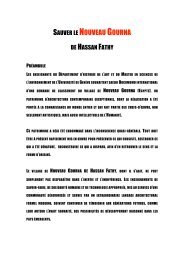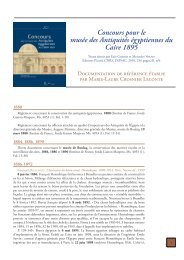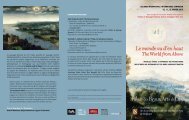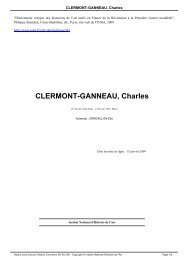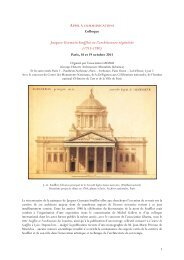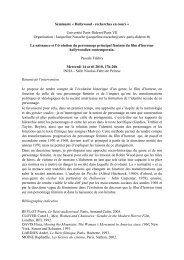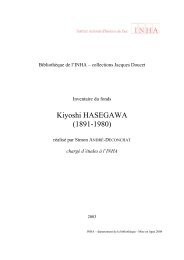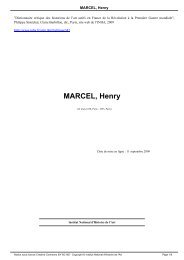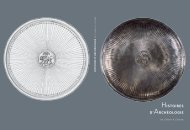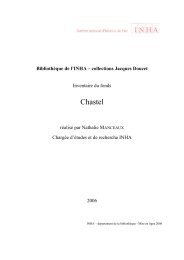Create successful ePaper yourself
Turn your PDF publications into a flip-book with our unique Google optimized e-Paper software.
which as yet to be assimilated in the era of sustainable development we are presently entering.<br />
The notion of “appropriate technology” formulated by Hassan Fathy at the twilight of his life<br />
has not been sufficiently acknowledged, in particular, in emergent countries.<br />
Hassan Fathy had a prolific mind and was passionate about numerous subjects. He designed<br />
and constructed projects of various nature; from modern constructions in armed concrete in the<br />
1930’s and private residences built with stone to projects for an “Ideal City” in Baghdad and<br />
Karachi during his Greek period. He addressed all types of programmes such as villas, farms,<br />
mosques, social health centres, schools, theatres, peasant villages and tourist villages. As a true<br />
researcher in the field of architecture and construction, he endeavoured to develop construction<br />
technologies by inventing solutions that would fit the climatic circumstances of hot arid<br />
countries. Although the project of NEW GOURNA is one of his important works, his career<br />
cannot be limited to this one and only realization.<br />
Hassan Fathy was motivated by a very strong social involvement combined with nationalist<br />
feelings and wished to develop adequate low-cost formulas drawn from the ancestral genius of<br />
the place, in priority for Egypt and then for the other Arab and African counties by which he was<br />
commissioned. The notion of “situated architecture” finds in him one of his champions. His<br />
constant concern was the integration of the building in its environment, finding inspiration in any<br />
possible heritage and answering the conditions imposed by the site.<br />
Hassan Fathy was a defender of traditional know-how and native crafts which were threatened<br />
of disappearing in favour of industrialized products imported from the West. Ideologically close<br />
to the artists of his time, like the group of the “Friends of Art and Life” founded in the 1930’s<br />
around the personality of Hamed Saïd, he preferred techniques which required the hand of man,<br />
believing they could bring happiness and dignity.<br />
Conscious of the importance of educating his compatriots and contemporaries, Hassan Fathy<br />
left numerous works and reports and gave a multitude of conferences. The memos, drafts,<br />
booklets scribbled with thoughts, notebooks and sketches are innumerable and constitute the<br />
most considerable part of the archives’ collection currently conserved at the American University<br />
of Cairo’s Rare Books Library and Special Collections (RBLSC). The classification of this<br />
material which is ongoing widens the knowledge of the vast and prolific production of this man.<br />
In his lifetime, he never received the recognition and grandstand he deserved even though in his<br />
late years, strangers from all over the world, desirous to benefit from his precepts, visited his<br />
house in Darb el Labana every day.<br />
Although Hassan Fathy was marginalized in his country, he was related to the international<br />
intelligentsias and he dedicated part of his career to expertise in the fields of development,<br />
2



